Accessing Gyroscope Data on Nano 33 BLE Rev2
Learn how to measure the direction of force to emulate an object's crash using the Nano 33 BLE Rev2.
This tutorial will focus on the 3-axis gyroscope sensor of the IMU system on the Arduino Nano 33 BLE Rev2, to measure the direction of force on the board to emulate an object's crash. This will be achieved by utilizing the values of the gyroscope's axes and later printing the return values through the Arduino IDE Serial Monitor.
Goals
The goals of this project are:
- Understand how the IMU system on the Nano 33 BLE Rev2 works.
- Use the BMI270_BMM150 library.
- Read data from the gyroscope's sensor.
- Convert the raw data into the direction of force.
- Print out live data through the Serial Monitor.
Hardware & Software Needed
- This project uses no external sensors or components apart from the Arduino Nano 33 BLE Rev2.
- In this tutorial, we will use the Arduino Cloud Editor to program the board.
The BMI270 & BMM150 Inertial Modules
IMU (Inertial Measurement Unit) is an electronic device that measures and reports a body's specific force, angular rate and the orientation of the body, using a combination of accelerometers, gyroscopes, and oftentimes magnetometers. In this tutorial, we will learn a bit more about the IMU system that is included in the Nano 33 BLE Rev2 board.
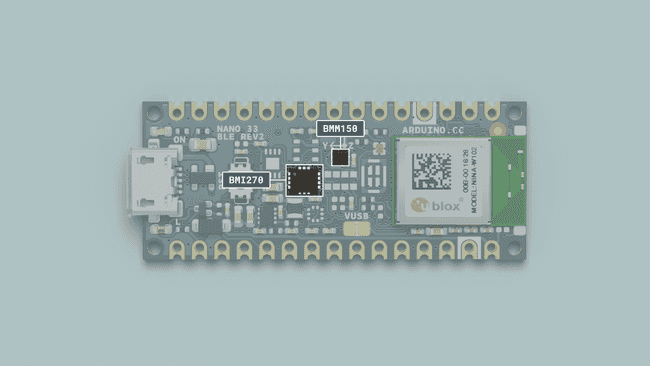
The IMU system on the Nano 33 BLE Rev2 is a combination of two modules, the 6-axis BMI270, and the 3-axis BMM150, that together add up to a combined 9-axis IMU system that can measure acceleration, as well as rotation and magnetic fields all in 3D space.
The Library
The Arduino BMI270_BMM150 library allows us to use the Nano 33 BLE Rev2 IMU modules without having to go into complicated programming. The library takes care of the sensor initialization and sets its values as follows:
- Accelerometer range is set at [-4, +4]g -/+0.122 mg.
- Gyroscope range is set at [-2000, +2000] dps +/-70 mdps.
- Magnetometer range is set at [-400, +400] uT +/-0.014 uT.
- Accelerometer output data rate is fixed at 104 Hz.
- Gyroscope output data rate is fixed at 104 Hz.
- Magnetometer output data rate is fixed at 20 Hz.
If you want to read more about the sensor modules that make up the IMU system, find the datasheet for the BMI270 and the BMM150 here.
Gyroscope
A gyroscope sensor is a device that can measure and maintain the orientation and angular velocity of an object. Gyroscopes are more advanced than accelerometers, as they can measure the tilt and lateral orientation of an object, whereas an accelerometer can only measure its linear motion.
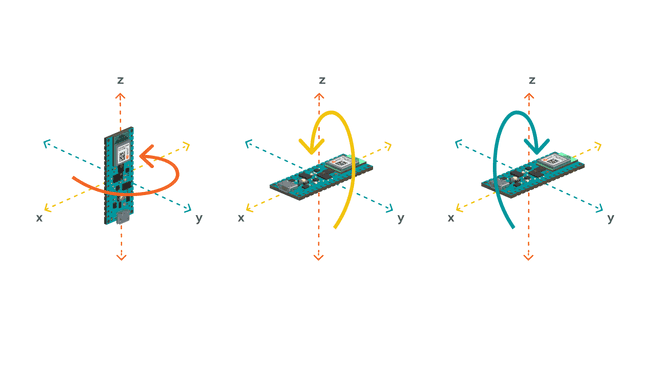
Gyroscope sensors are also called "Angular Rate Sensors" or "Angular Velocity Sensors". Measured in degrees per second, angular velocity is the change in the rotational angle of the object per unit of time.
In this example, we will use the gyroscope as an indicator for the direction of the force that is applied to the board. This will be achieved by swiftly moving the board for an instant in four directions: forward, backward, to the left and the right. The results will be visible through the Serial Monitor.
Creating the Program
1. Setting up
Let's start by opening the Arduino Cloud Editor, clicking on the Libraries tab and searching for the BMI270_BMM150 library. Then in > Examples, open the SimpleGyroscope sketch and once it opens, rename it as Gyroscope.
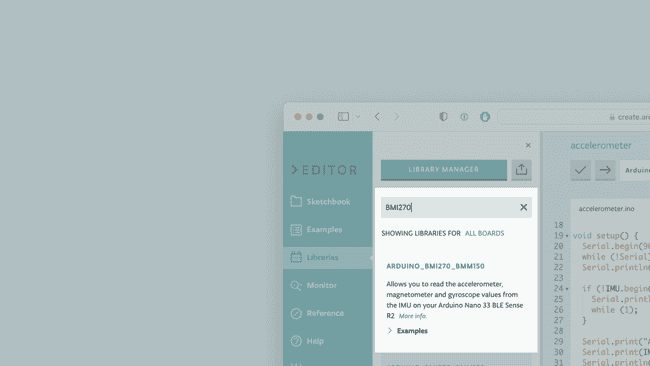
2. Connecting the board
Now, connect the Nano 33 BLE Rev2 to the computer and make sure that the Cloud Editor recognizes it, if so, the board and port should appear as shown in the image below. If they don't appear, follow the instructions to install the plugin that will allow the editor to recognize your board.
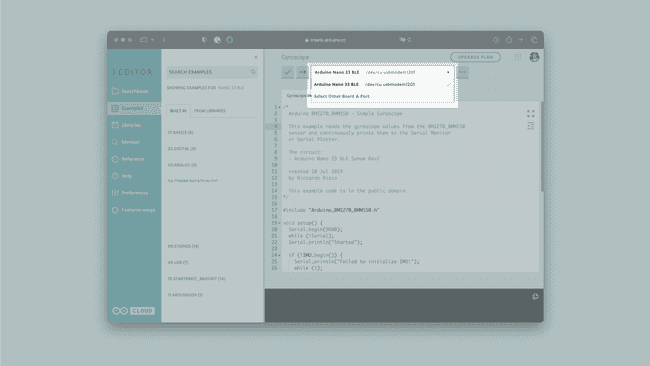
3. Printing the board's direction of force
Now we will need to modify the code on the example, to print the board's direction of force as we move it in different angles.
Let's start by initializing the x, y, and z axes as
floatint plusThreshold = 30;int minusThreshold = -30;setup()In the
setup()1Serial.println("X\tY\tZ");Next, in the
loop()1float x, y, z;as well as the following lines that won't be required:
1Serial.print(x);2Serial.print('\t');3Serial.print(y);4Serial.print('\t');5Serial.println(z);Instead, we will add four
ifHere is the code we will add:
1if(y > plusThreshold)2{3Serial.println("Collision front");4delay(500);5}6if(y < minusThreshold)7{8Serial.println("Collision back");9delay(500);10}11if(x < minusThreshold)12{13Serial.println("Collision right");14delay(500);15}16if(x > plusThreshold)17{18Serial.println("Collision left");19delay(500);20}These
ifplusThresholdminusThreshold4. Complete code
If you choose to skip the code-building section, the complete code can be found below:
1/*2 Arduino BMI270_BMM150 - Simple Gyroscope3
4 This example reads the gyroscope values from the BMI270_BMM1505 sensor and continuously prints them to the Serial Monitor6 or Serial Plotter.7
8 The circuit:9 - Arduino Nano 33 BLE Rev210
11 created 10 Jul 201912 by Riccardo Rizzo13
14 This example code is in the public domain.15*/16
17#include "Arduino_BMI270_BMM150.h"18
19float x, y, z;20
21int plusThreshold = 30, minusThreshold = -30;22
23void setup() {24 Serial.begin(9600);25 while (!Serial);26 Serial.println("Started");27
28 if (!IMU.begin()) {29 Serial.println("Failed to initialize IMU!");30 while (1);31 }32 Serial.print("Gyroscope sample rate = ");33 Serial.print(IMU.gyroscopeSampleRate());34 Serial.println(" Hz");35 Serial.println();36 Serial.println("Gyroscope in degrees/second");37}38
39void loop() {40
41 if (IMU.gyroscopeAvailable()) {42 IMU.readGyroscope(x, y, z);43
44 if(y > plusThreshold)45 {46 Serial.println("Collision front");47 delay(500);48 }49 if(y < minusThreshold)50 {51 Serial.println("Collision back");52 delay(500);53 }54 if(x < minusThreshold)55 {56 Serial.println("Collision right");57 delay(500);58 }59 if(x > plusThreshold)60 {61 Serial.println("Collision left");62 delay(500);63 }64 }65}Testing It Out
In order to get a correct reading of the board data, before uploading the sketch to the board hold the board in your hand, from the side of the USB port. The board should be facing up and "pointing" away from you. The image below illustrates the board's position and how it works:
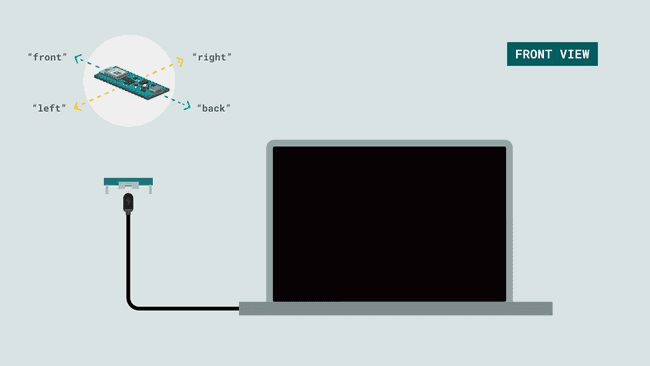
Next, you can verify and upload the sketch to the board and open the Monitor from the menu on the left.
Now with the board parallel to the ground, you can swiftly move it in one direction: forward, backward, right or left. According to the movement of your choice, the results will print every second to your monitor!
Here is a screenshot of the sketch returning these values:
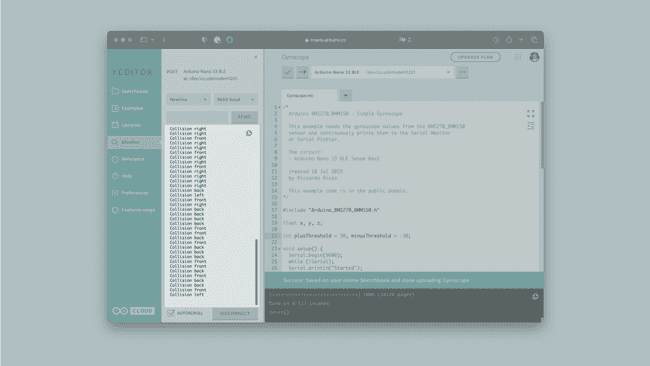
Troubleshoot
Sometimes errors occur, if the code is not working there are some common issues we can troubleshoot:
- Missing a bracket or a semicolon.
- The Arduino board is connected to the wrong port.
- Accidental interruption of cable connection.
Conclusion
In this simple tutorial, we learned what an IMU sensor module is, how to use the BMI270_BMM150 library, and how to use an Arduino Nano 33 BLE Rev2 microcontroller, to measure and print out values from a gyroscope sensor. Furthermore, we created an application that detects the direction of force that we can apply to the board.
Suggest changes
The content on docs.arduino.cc is facilitated through a public GitHub repository. If you see anything wrong, you can edit this page here.
License
The Arduino documentation is licensed under the Creative Commons Attribution-Share Alike 4.0 license.